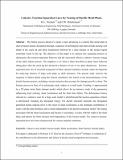| dc.contributor.author | Nielsen, K. L. | |
| dc.contributor.author | Hutchinson, John W. | |
| dc.date.accessioned | 2013-01-14T16:34:06Z | |
| dc.date.issued | 2012 | |
| dc.identifier.citation | Nielsen, K. L., and John W. Hutchinson. 2012. Cohesive traction–separation laws for tearing of ductile metal plates. International Journal of Impact Engineering 48:15-23. | en_US |
| dc.identifier.issn | 0734-743X | en_US |
| dc.identifier.uri | http://nrs.harvard.edu/urn-3:HUL.InstRepos:10163031 | |
| dc.description.abstract | The failure process ahead of a mode I crack advancing in a ductile thin metal plate or sheet produces plastic dissipation through a sequence of deformation steps that include necking well ahead of the crack tip and shear localization followed by a slant fracture in the necked region somewhat closer to the tip. The objective of this paper is to analyze this sequential process to characterize the traction–separation behavior and the associated effective cohesive fracture energy of the entire failure process. The emphasis is on what is often described as plane stress behavior taking place after the crack tip has advanced a distance of one or two plate thicknesses. Traction–separation laws are an essential component of finite element methods currently under development for analyzing fracture of large scale plate or shell structures. The present study resolves the sequence of failure details using the Gurson constitutive law based on the micromechanics of the ductile fracture process, including a recent extension that accounts for damage growth in shear. The fracture process in front of an advancing crack, subject to overall mode I loading, is approximated by a 2D plane strain finite element model, which allows for an intensive study of the parameters influencing local necking, shear localization and the final slant failure. The deformation history relevant to a cohesive zone for a large scale model is identified and the traction–separation relation is determined, including the dissipated energy. For ductile structural materials, the dissipation generated during necking prior to the onset of shear localization is the dominant contribution; it scales with the plate thickness and is mesh-independent in the present numerical model. The energy associated with the shear localization and fracture is secondary; it scales with the width of the shear band, and inherits the finite element mesh dependency of the Gurson model. The cohesive traction–separation laws have been characterized for various material conditions. | en_US |
| dc.description.sponsorship | Engineering and Applied Sciences | en_US |
| dc.language.iso | en_US | en_US |
| dc.publisher | Elsevier | en_US |
| dc.relation.isversionof | doi:10.1016/j.ijimpeng.2011.02.009 | en_US |
| dash.license | OAP | |
| dc.subject | cohesive zone model | en_US |
| dc.subject | Gurson model | en_US |
| dc.subject | shear localization | en_US |
| dc.subject | slant fracture | en_US |
| dc.subject | ductile plates | en_US |
| dc.title | Cohesive Traction-Separation Laws for Tearing of Ductile Metal Plates | en_US |
| dc.type | Journal Article | en_US |
| dc.description.version | Author's Original | en_US |
| dc.relation.journal | International Journal of Impact Engineering | en_US |
| dash.depositing.author | Hutchinson, John W. | |
| dc.date.available | 2013-01-14T16:34:06Z | |
| dc.identifier.doi | 10.1016/j.ijimpeng.2011.02.009 | * |
| dash.contributor.affiliated | Hutchinson, John | |


